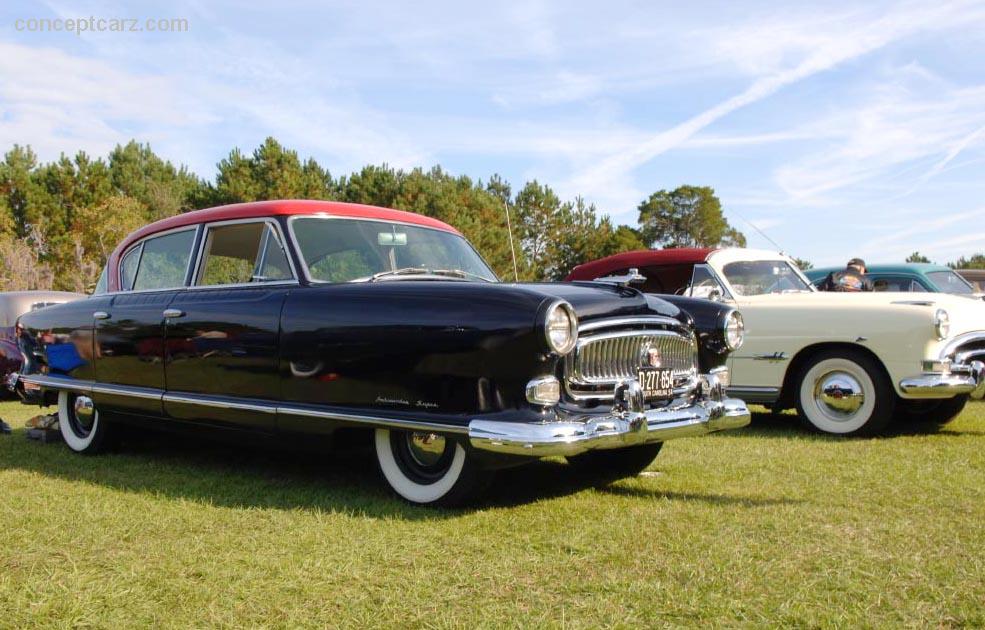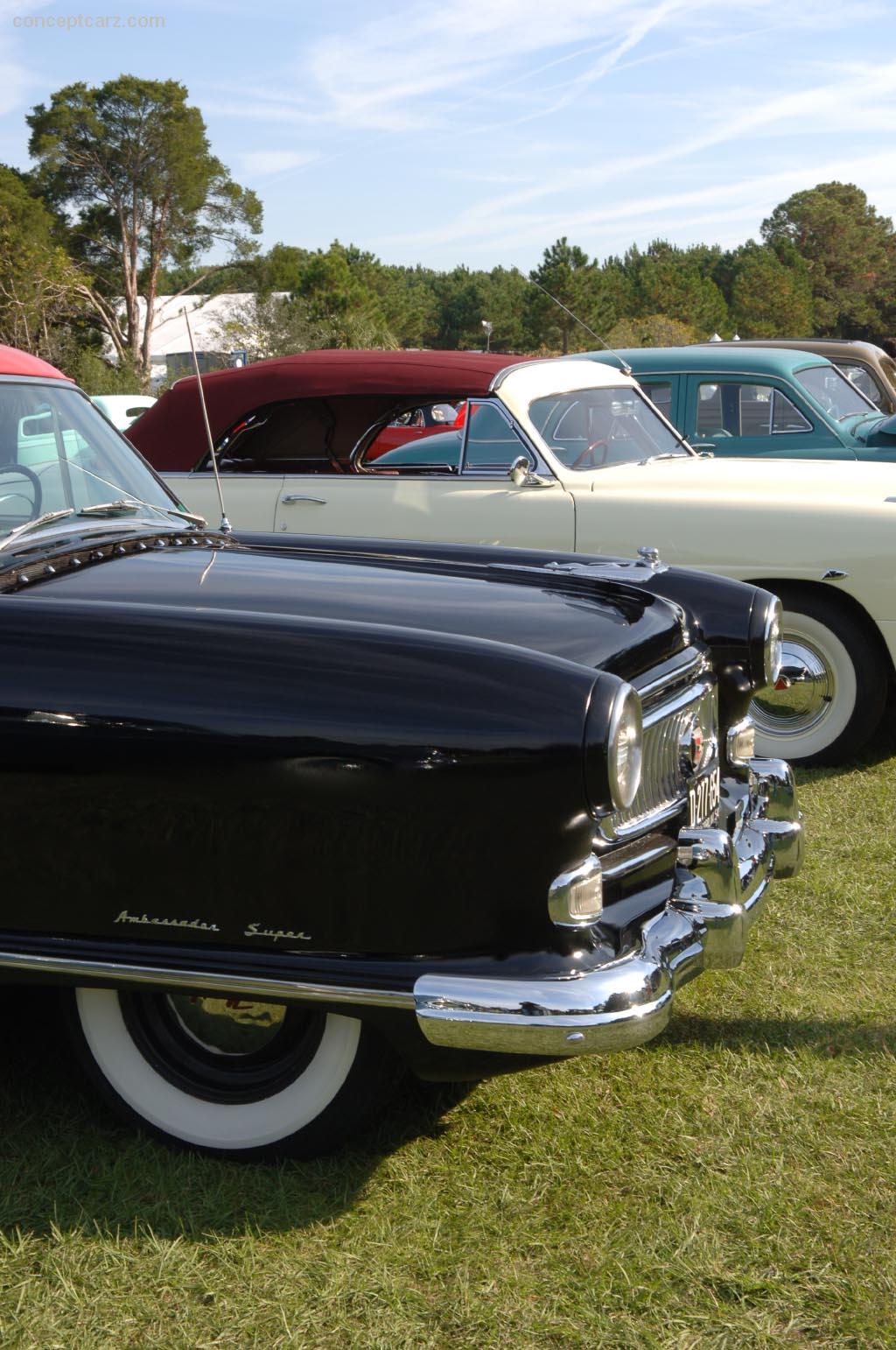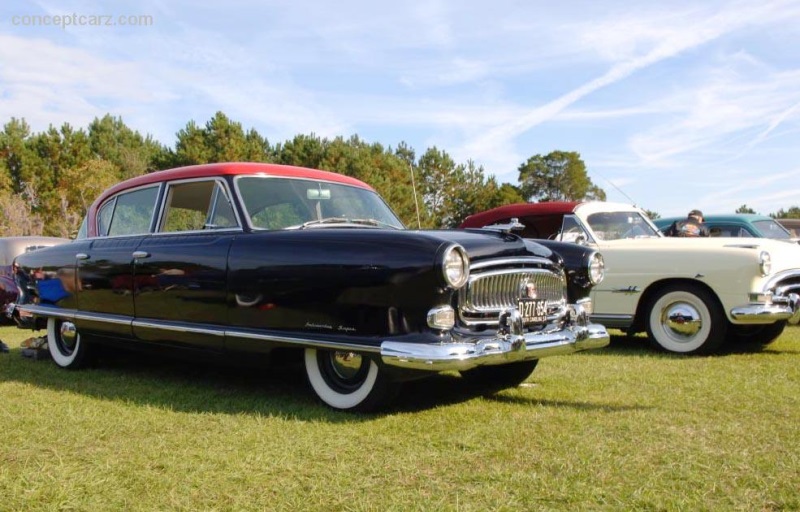The Ambassador model was part of the Nash lineup from 1932 until 1957 serving as the top-of-the-line model, and a part of the American Motors line from 1954 to 1974. Following World War II, the Nash lineup consisted of the Nash 600 resting on a 112-inch wheelbase platform and the Ambassador on a 121-inch wheelbase. The Nash 600 had a 172.6 cubic-inch inline-6 with 82 horsepower and the Ambassador had a 234.8 CID inline-6 with 112 horsepower. Both had pre-war styling with minor modifications and built using unitized construction with separate chassis and frame engineering. 
Super Line Sedan
View info and historyAll-new styling arrived in 1949 and the changes made to the 600 were applied to the Ambassador. Both had unitized single-unit construction, making Nash the first United States manufacturer of mass-produced automobiles to employ this construction technique. Styling features included a one-piece curved windshield, rounded body lines, round headlights built into the fenders, and fully enclosed wheel covers. The rounded design earned the cars the nickname, 'bathtubs.' 1952 was the 50th anniversary of Nash Motor Co. (the predecessor firm, the Thomas B. Jeffery Company had marketed its first cars in 1902) and Nash used the occasion to introduce all-new styling. The designs were courtesy of Italian designer Pinin Farina along with input from Edmund E. Anderson, the lead designer at Nash. The preceding design was modernized and given more conventional lines than the previous 1949 to 1951 Ambassadors, continuing to use rounded 'envelope' bodies and enclosed fenders, along with several European touches such as the reverse-slanted C-pillars. Several design awards were bestowed upon the new Nash vehicles and the exteriors would remain mostly unchanged through 1954. The 1954 Nash
The Nash model lineup for 1954 included the entry-level Rambler, the intermediate-priced Statesman, and the top-of-the-line Ambassador. The Rambler Series 10 used a 100-inch wheelbase, the Rambler four-door body styles had a 108-inch wheelbase, the Statesman measured 114.3-inches, and the Ambassador rested on a 121.3-inch platform. The Rambler was priced from $1,445 to $2,200, the Statesman listed from $2,130 to $2,470, and the Ambassador was priced in the mid-$2,000 range. The Rambler was equipped with a 184.1 cubic-inch engine offering 85 horsepower and the Statesman used a 195.6 cubic-inch inline-6 with 110 horsepower.
Custom Line Sedan
Chassis #: r738050
View info and history
Auction entries : 1The Ambassador was equipped with a 252.6 cubic-inch inline-6 with overhead valves, solid valve lifters, seven main bearings, a Carter one-barrel carburetor, and delivering 130 horsepower at 3,700 RPM. The 1954 Ambassador was the first American automobile to have a fully integrated heating, ventilating, and air-conditioning system in the front end. Other manufacturers of the era offered Air Conditioning systems on some models, but their units were driven by a trunk-mounted expander and heat exchanger, with the air funneled to the interior through tubes and ceiling-mounted vents. The heating and ventilation system in the Ambassador, called the Weather Eye, could be fitted with Nash-Kelvinators' advanced Automobile air conditioning unit. The styling changes were minimal, with a new 'floating' concave grille, partially chromed headlamp bezels, a new interior, and a new instrument panel. Trim levels included the 'Super' and the 'Custom,' and both were offered as a two- and four-door sedan. The 'Custom' trim level included a continental spare tire carrier. The two-door 'Super' sedan had a base price of $2,360 and the four-door sedan listed at $2,410. The 'Custom' two-door hardtop 'Country Club' coupe was $2,730 and the four-door sedan listed for $2,600. The Custom line was more popular than the Super, with 10,131 of the four-door sedan and 3,581 of the hardtop coupe. 283 were two-door 'Super' and 7,433 were four-door sedans. 
Super Line Sedan
View info and historyOn January 14th of 1954, Nash-Kelvinator merged with the Hudson Motor Car Company, forming American Motors Corporation (AMC), and both Hudson and Nash dealers sold Ramblers that were identical except for the 'Nash' or 'Hudson' badging. The other Nash and Hudson models continued to be a part of the lineup.
by Daniel Vaughan | Apr 2021

Super Line Sedan
View info and history
The Nash model lineup for 1954 included the entry-level Rambler, the intermediate-priced Statesman, and the top-of-the-line Ambassador. The Rambler Series 10 used a 100-inch wheelbase, the Rambler four-door body styles had a 108-inch wheelbase, the Statesman measured 114.3-inches, and the Ambassador rested on a 121.3-inch platform. The Rambler was priced from $1,445 to $2,200, the Statesman listed from $2,130 to $2,470, and the Ambassador was priced in the mid-$2,000 range. The Rambler was equipped with a 184.1 cubic-inch engine offering 85 horsepower and the Statesman used a 195.6 cubic-inch inline-6 with 110 horsepower.

Custom Line Sedan
Chassis #: r738050
View info and history
Auction entries : 1

Super Line Sedan
View info and history
by Daniel Vaughan | Apr 2021
Related Reading : Nash Ambassador History
The Nash Ambassador was produced from 1932 through 1957. When Nash merged with Hudson Motors in 1954, the Ambassador name was continued, though it was now known as the AMC Ambassador. The name persisted until 1974. The Ambassador was Nashs top-of-the-line offering when first introduced. These vehicles were outfitted with fine upholstery and luxury amenities. The base price was set at %242,090. In....
Continue Reading >>
Continue Reading >>
Related Reading : Nash Ambassador History
The name Ambassador was used to designate a senior line of Nash Motors automobiles, a product of American Motors Corporation. The Ambassador was a high trim option on Nashs senior models from 1927 until 1931. During the 1927 model year, a five passenger sedan version of the Nashs 267 model, the advance Six automobile with a trimmed four door was introduced, and it was the most expensive vehicle....
Continue Reading >>
Continue Reading >>
Similarly Priced Vehicles
DeSoto Firedome ($2,650-$3,557)
Ford Crestline ($1,900-$2,415)
Studebaker Commander ($1,980-$2,555)
Kaiser Manhattan ($2,400-$2,450)
Dodge Coronet ($2,085-$2,795)
Sunbeam Talbot 90 ($2,700-$2,900)
Oldsmobile Super Eighty-Eight ($2,185-$2,510)
Oldsmobile Ninety-Eight ($2,550-$2,960)
Average Auction Sale: $6,600
Ford Crestline ($1,900-$2,415)
Studebaker Commander ($1,980-$2,555)
Kaiser Manhattan ($2,400-$2,450)
Dodge Coronet ($2,085-$2,795)
Sunbeam Talbot 90 ($2,700-$2,900)
Oldsmobile Super Eighty-Eight ($2,185-$2,510)
Oldsmobile Ninety-Eight ($2,550-$2,960)
Average Auction Sale: $6,600
1954 Nash Ambassador Vehicle Profiles
Recent Vehicle Additions
Performance and Specification Comparison
Price Comparison
$1,445 - $3,000
Ambassador Specification Comparison by Year
Year
Production
Wheelbase
Engine
Prices
15,531
121.30 in.
6 cyl., 252.60 CID., 135.00hp
8 cyl., 250.00 CID., 190.00hp
8 cyl., 352.00 CID., 220.00hp
8 cyl., 250.00 CID., 190.00hp
8 cyl., 352.00 CID., 220.00hp
$2,350 - $3,340

















